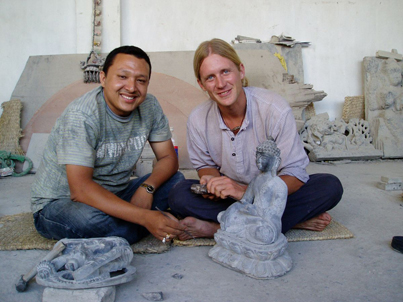Training in nepal
After my first introduction to stone carving in 1993 I continued to sculpt and remained self taught until traveling to Nepal in 1998. Kathmandu has an ancient but vibrantly living artistic heritage, seen in the intricate stone carvings found in temples, shrines and shops all over the city. I sought out a teacher and was very fortunate to find a master stone carver whose family was patronized by the Royal Family of Nepal and whose ancestors were the architects and sculptors of many of Kathmandu’s great stone temples.

With Jaya Raj Bajracharya, 1999
I soon found myself sitting on a straw mat on the floor of his factory trying to emulate the other Nepali apprentice carvers who sat cross legged, gripping the stones with their toes in front of them and leaning forward to carve from all sides. I think it was amusing for them to see me struggle so much in what for someone who has grown up without chairs is a most natural position. I never managed to adapt naturally to this position, and when my knees and back had had enough I would leave my fellow carvers where they had been sitting when I arrived and where they remained carving long after I left.

With Jaya Raj Bajracharya, 2008
My training began with the delivery of three roughly hewn stones which I was told to “make plane”, or to carve into perfectly proportioned rectangular blocks which I would transfer my dimensional drawings to before sculpting. Three months later I managed to accomplish what would have taken a few strokes of a masonry saw- a block which matched the smooth edge of a ruler on all six sides. Knowing that the work could be easily executed by a machine made the process feel aggravatingly slow and tedious, but I knew my patience and determination were being tested to ascertain whether I was worth teaching. After so much work only to create pieces to cut into again, I was itching to begin carving what I was most interested to learn, a statue of the Buddha. When I was told I would carve all three blocks into Bhimsen, the deity of commerce, and then two more before carving new blocks and then eventually Buddha statues, I decided I had to insist on a more direct approach.

Shakyamuni Buddha carved in 2001
I was told that Buddha is in fact the hardest of all statues to carve. Unlike other statues where mistakes in proportion can be concealed under the folds of clothing, the Buddha’s simplicity and anciently defined exact proportions leave little room for error. “After 5 years one is ready to carve Buddha statues” my teacher Jaya said. I tried to convince Jaya that I might not have that long and that perhaps he could make an exception for me.
He took time to consider, for as I later found out, his father was wary of his having taken on a western student and disapproved of my interest in learning to carve Buddha statues as it would involve learning the family’s carefully guarded dimensional drawings which had insured their livelihood for generations. Fortunately my teacher is a broad minded person, and surely also saw that I did not present much of a threat to the family industry, so he eventually agreed.

Shakyamuni Buddha carved in 2001

Stone Carving in Bhaktapur, Nepal

Stone Carving in Bhaktapur, Nepal
I am indebted to him for his patience in taking on such an itinerant student and for the exceptions he made for me. I learned a great deal watching his hands move in fluid effortless coordination as the figure emerged from the stone. Although my work now has moved toward relief carving (and I choose to carve standing up!), that training gave me the foundation to carve nearly anything in stone.
I have continued to visit my teacher in Kathmandu since 1999 and he has come to visit to the states and has shown his work in Boston.